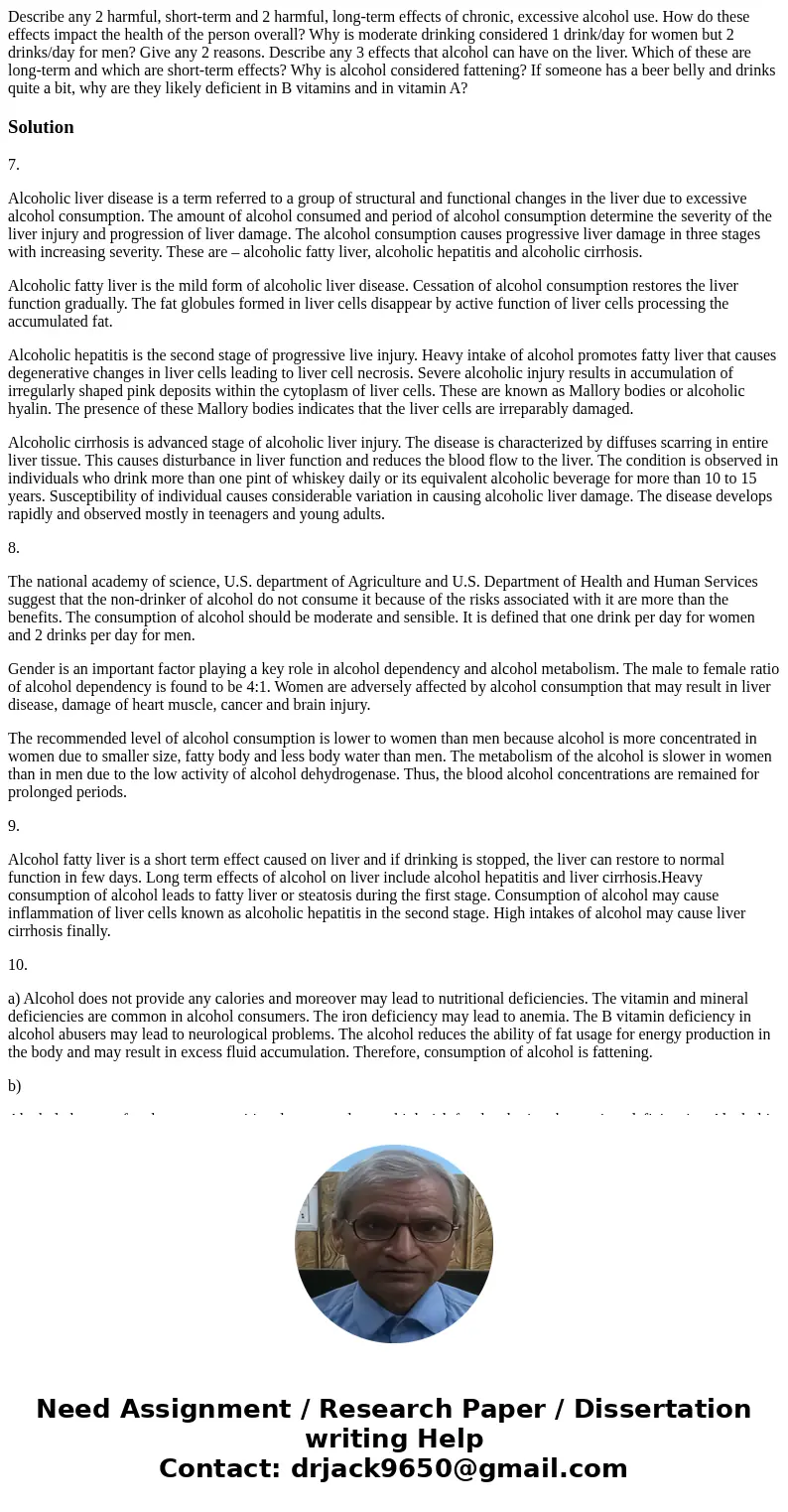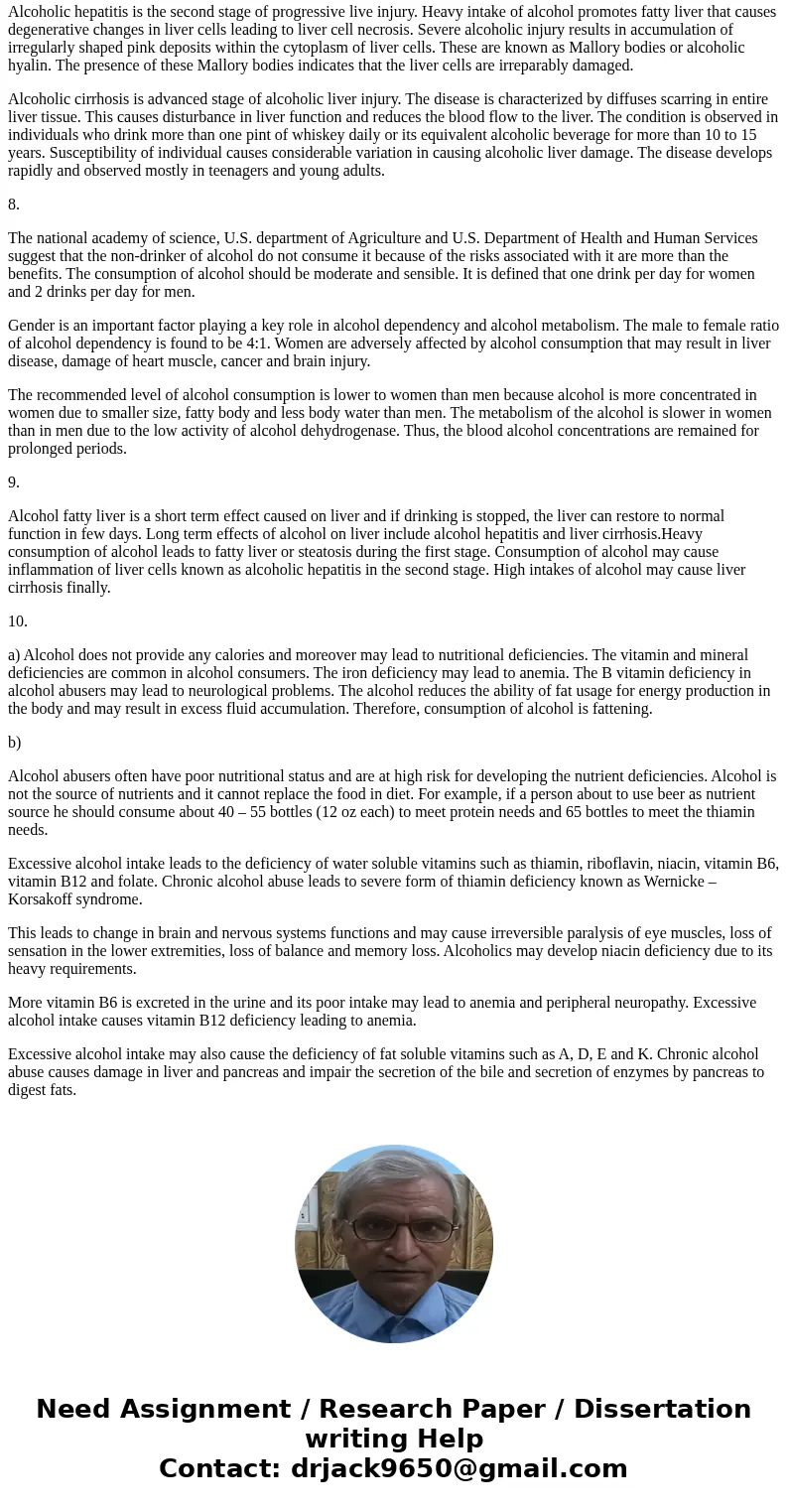Describe any 2 harmful shortterm and 2 harmful longterm effe
Solution
7.
Alcoholic liver disease is a term referred to a group of structural and functional changes in the liver due to excessive alcohol consumption. The amount of alcohol consumed and period of alcohol consumption determine the severity of the liver injury and progression of liver damage. The alcohol consumption causes progressive liver damage in three stages with increasing severity. These are – alcoholic fatty liver, alcoholic hepatitis and alcoholic cirrhosis.
Alcoholic fatty liver is the mild form of alcoholic liver disease. Cessation of alcohol consumption restores the liver function gradually. The fat globules formed in liver cells disappear by active function of liver cells processing the accumulated fat.
Alcoholic hepatitis is the second stage of progressive live injury. Heavy intake of alcohol promotes fatty liver that causes degenerative changes in liver cells leading to liver cell necrosis. Severe alcoholic injury results in accumulation of irregularly shaped pink deposits within the cytoplasm of liver cells. These are known as Mallory bodies or alcoholic hyalin. The presence of these Mallory bodies indicates that the liver cells are irreparably damaged.
Alcoholic cirrhosis is advanced stage of alcoholic liver injury. The disease is characterized by diffuses scarring in entire liver tissue. This causes disturbance in liver function and reduces the blood flow to the liver. The condition is observed in individuals who drink more than one pint of whiskey daily or its equivalent alcoholic beverage for more than 10 to 15 years. Susceptibility of individual causes considerable variation in causing alcoholic liver damage. The disease develops rapidly and observed mostly in teenagers and young adults.
8.
The national academy of science, U.S. department of Agriculture and U.S. Department of Health and Human Services suggest that the non-drinker of alcohol do not consume it because of the risks associated with it are more than the benefits. The consumption of alcohol should be moderate and sensible. It is defined that one drink per day for women and 2 drinks per day for men.
Gender is an important factor playing a key role in alcohol dependency and alcohol metabolism. The male to female ratio of alcohol dependency is found to be 4:1. Women are adversely affected by alcohol consumption that may result in liver disease, damage of heart muscle, cancer and brain injury.
The recommended level of alcohol consumption is lower to women than men because alcohol is more concentrated in women due to smaller size, fatty body and less body water than men. The metabolism of the alcohol is slower in women than in men due to the low activity of alcohol dehydrogenase. Thus, the blood alcohol concentrations are remained for prolonged periods.
9.
Alcohol fatty liver is a short term effect caused on liver and if drinking is stopped, the liver can restore to normal function in few days. Long term effects of alcohol on liver include alcohol hepatitis and liver cirrhosis.Heavy consumption of alcohol leads to fatty liver or steatosis during the first stage. Consumption of alcohol may cause inflammation of liver cells known as alcoholic hepatitis in the second stage. High intakes of alcohol may cause liver cirrhosis finally.
10.
a) Alcohol does not provide any calories and moreover may lead to nutritional deficiencies. The vitamin and mineral deficiencies are common in alcohol consumers. The iron deficiency may lead to anemia. The B vitamin deficiency in alcohol abusers may lead to neurological problems. The alcohol reduces the ability of fat usage for energy production in the body and may result in excess fluid accumulation. Therefore, consumption of alcohol is fattening.
b)
Alcohol abusers often have poor nutritional status and are at high risk for developing the nutrient deficiencies. Alcohol is not the source of nutrients and it cannot replace the food in diet. For example, if a person about to use beer as nutrient source he should consume about 40 – 55 bottles (12 oz each) to meet protein needs and 65 bottles to meet the thiamin needs.
Excessive alcohol intake leads to the deficiency of water soluble vitamins such as thiamin, riboflavin, niacin, vitamin B6, vitamin B12 and folate. Chronic alcohol abuse leads to severe form of thiamin deficiency known as Wernicke – Korsakoff syndrome.
This leads to change in brain and nervous systems functions and may cause irreversible paralysis of eye muscles, loss of sensation in the lower extremities, loss of balance and memory loss. Alcoholics may develop niacin deficiency due to its heavy requirements.
More vitamin B6 is excreted in the urine and its poor intake may lead to anemia and peripheral neuropathy. Excessive alcohol intake causes vitamin B12 deficiency leading to anemia.
Excessive alcohol intake may also cause the deficiency of fat soluble vitamins such as A, D, E and K. Chronic alcohol abuse causes damage in liver and pancreas and impair the secretion of the bile and secretion of enzymes by pancreas to digest fats.


 Homework Sourse
Homework Sourse